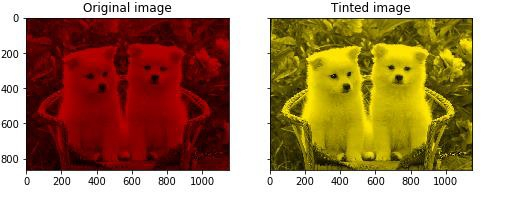
 Data Structure
Data Structure Networking
Networking RDBMS
RDBMS Operating System
Operating System Java
Java MS Excel
MS Excel iOS
iOS HTML
HTML CSS
CSS Android
Android Python
Python C Programming
C Programming C++
C++ C#
C# MongoDB
MongoDB MySQL
MySQL Javascript
Javascript PHP
PHP
- Selected Reading
- UPSC IAS Exams Notes
- Developer's Best Practices
- Questions and Answers
- Effective Resume Writing
- HR Interview Questions
- Computer Glossary
- Who is Who
How can a specific tint be added to grayscale images in scikit-learn in Python?
The values of ‘R’, ‘G’, and ‘B’ are changed and applied to the original image to get the required tint.
Below is a Python program that uses scikit-learn to implement the same. Scikit-learn, commonly known as sklearn is a library in Python that is used for the purpose of implementing machine learning algorithms −
Example
import matplotlib.pyplot as plt
from skimage import data
from skimage import color
path = "path to puppy_1.jpg"
orig_img = io.imread(path)
grayscale_img = rgb2gray(orig_img)
image = color.gray2rgb(grayscale_img)
red_multiplier = [0.7, 0, 0]
yellow_multiplier = [1, 0.9, 0]
fig, (ax1, ax2) = plt.subplots(ncols=2, figsize=(8, 4),
sharex=True, sharey=True)
ax1.imshow(red_multiplier * image)
ax1.set_title('Original image')
ax2.imshow(yellow_multiplier * image)
ax2.set_title('Tinted image')
Output

Explanation
The required packages are imported into the environment.
The path where the image is stored is defined.
The ‘imread’ function is used to visit the path and read the image.
The ‘imshow’ function is used to display the image on the console.
The function ‘rgb2gray’ is used to convert the image from RGB color space to grayscale color space.
The function ‘gray2rgb’ is used to convert the image from grayscale to RGB color space.
The matplotlib library is used to plot this data on console.
The R, G, B values for the multipliers are defined and applied on the image.
Output is displayed on the console.

